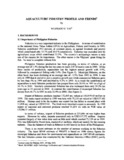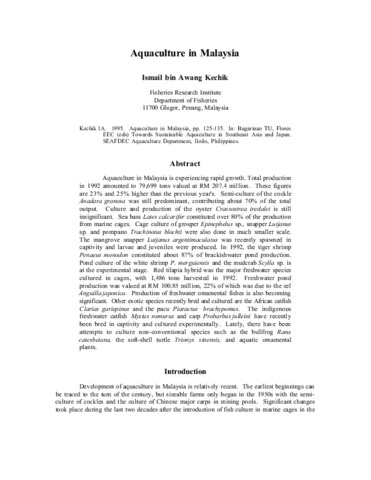Presence of snapper, seabass, and siganid inhibits growth of luminous bacteria in a simulated shrimp culture system
- Global styles
- MLA
- Vancouver
- Elsevier - Harvard
- APA
- Help

View/
Date
2006Page views
4,192ASFA keyword
AGROVOC keyword
Taxonomic term
Metadata
Perlihat publikasi penuhCited times in Scopus
Share
Abstract
The antibacterial effect of the presence of Tilapia hornorum against luminous bacteria in shrimp culture has been reported. This study investigates how the presence of commercially valued marine species such as seabass, snapper and siganid affect the growth of luminous bacteria in shrimp culture water. Results showed that luminous bacterial count of water stocked with seabass, siganid and snapper are significantly lower than those without fish. Therefore this study has demonstrated that seabass, siganid and snapper are alternative species for culture with shrimp to control or inhibit the growth of luminous bacteria in shrimp ponds.
Suggested Citation
Tendencia, E., dela Peña, M. R., & Choresca, C. H., Jr. (2006). Presence of snapper, seabass, and siganid inhibits growth of luminous bacteria in a simulated shrimp culture system. Aquaculture , 260(1–4), 54-60. https://doi.org/10.1016/j.aquaculture.2006.05.060
Type
ArticleISSN
0044-8486Koleksi
- Journal Articles [1229]
Related items
Showing items related by title, author, creator and subject.
-
Aquaculture industry profile and trends
Yap, Wilfredo G. (University of the Philippines Aquaculture Society, Inc., 2001) -
Aquaculture in Malaysia
Kechik, Ismail bin Awang. (Aquaculture Department, Southeast Asian Fisheries Development Center, 1995)Aquaculture in Malaysia is experiencing rapid growth. Total production in 1992 amounted to 79,699 tons valued at RM 207.4 million. These figures are 23% and 25% higher than the previous year's. Semi-culture of the cockle ... -
Coastal aquaculture in Thailand
Sahavacharin, Songchai (Aquaculture Department, Southeast Asian Fisheries Development Center, 1995)Coastal aquaculture in Thailand has expanded rapidly in both area and production in the last decade. The important cultured species are the shrimps (Penaeus monodon and P. merguiensis), sea bass Lates calcarifer, groupers ...






